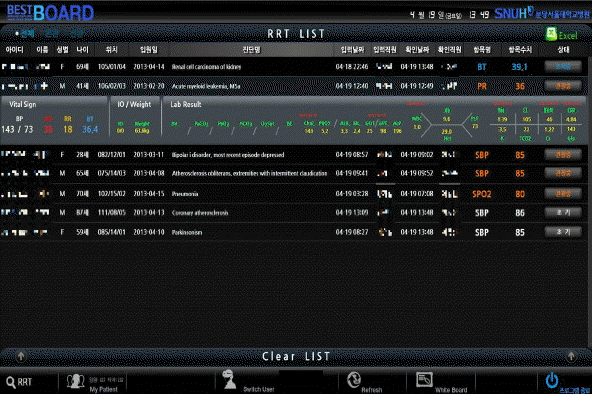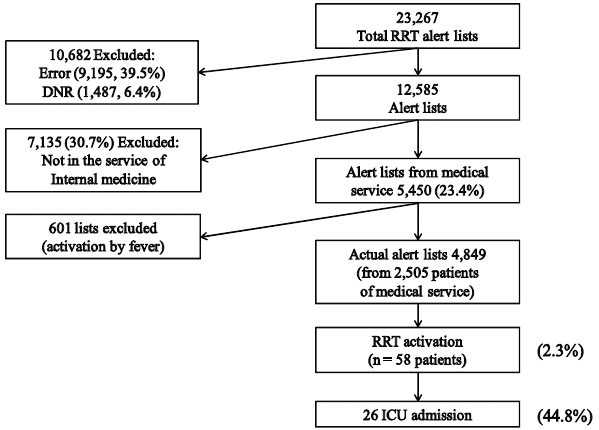INTRODUCTION
MATERIALS AND METHODS
1) Participants
2) Activity and RRS operation
Table 1.
3) Statistical analysis
RESULTS
1) RRS activations and interventions
Table 2.
| Characteristic | Values |
|---|---|
| Rapid response system activations, n (%) | 58 (2.3) |
| Age (y), mean ± SD | 67.1 ± 11.8 |
| Male sex, n (%) | 36 (60) |
| Activation methods, n (%) | |
| Screening | 46 (79) |
| Call | 9 (16) |
| Others | 3 (5) |
| Wards, n (%) | |
| Hemato-oncology | 29 (48.3) |
| Pulmonology | 13 (21.7) |
| Gastroenterology | 6 (10.0) |
| Geriatric medicine | 5 (8.3) |
| Nephrology | 4 (6.7) |
| Cardiology | 1 (1.7) |
| Response time (min), mean ± SD | 7.6 ± 7.0 |
| Modified early warning score, mean ± SD | 4.7 ± 2.1 |
| Reasons for activation, n (%) | |
| 1. Low BP (SBP < 90 mmHg) | 15 (25.9) |
| 2. HR (< 50/min, > 140/min, or symptomatic arrhythmia) | 10 (17.2) |
| 3. RR (< 10/min, > 30/min, accessory muscle use, or stridor) | 13 (22.4) |
| 4. BT (> 39°C or < 36°C) | 2 (3.4) |
| 5. Pain: chest pain suggesting angina | 0 (0) |
| 6. Neurology | 0 (0) |
| 7. Oxygenation (SaO2 < 90% in room air or FM > O2 8L/min) | 23 (39.7) |
| 8. ABGA abnormality: PaCO2 > 50 mmHg, pH < 7.3, or PaO2 < 60 mmHg | 2 (3.4) |
| 9. Metabolic acidosis: lactic acid > 2.5 mmol/L, TCO2 < 15 mmol/L | 0 (0) |
| 10. Any serious concerns about overall deterioration | 1 (1.7) |
| Recommendation, n (%) | |
| A: ICU admission | 26 (44.8) |
| B*: Borderline intervention | 21 (36.2) |
| C†: Consultation only | 4 (6.9) |
| D‡: Do not resuscitate | 7 (12.1) |
| Survival rate, n (%) | 37 (63.8) |
| LOS in hospital, mean ± SD | 28.9 ± 20.5 |
* volume replacement (11), use antibiotics, order laboratory and radiologic exams (8), adequate oxygen supply (4), emergency embolization for bleeding (2), recommend esophagoduodenoscopy (1), use medication for HR control (1), apply noninvasive ventilation (1).
† problems solved in accounting department (2), do not resuscitate was not described in the emergency medical records (1), transient change due to analgesics (1).
‡ Lung cancer (3), pancreatic cancer (1), extramammary Paget’s disease (1), aspiration pneumonia (2). SD: standard deviation; BP: blood pressure; SBP: systolic blood pressure; HR: heart rate; RR: respiratory rate; BT: body temperature; ABGA: arterial blood gas analysis; ICU: intensive care unit; LOS: length of stay.




 PDF
PDF Citation
Citation Print
Print




 XML Download
XML Download